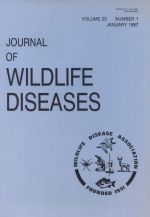Sera collected from a captive population of white-tailed deer (Odocoileus virginianus) penned in the lower peninsula of Michigan were assayed over a 29-mo period for neutralizing antibody to California serogroup viruses. In all, 130 individual white-tailed deer were bled one to 22 times between June 1983 and November 1985. Of the 130 sampled after active transmission had ceased, or passage of maternal antibody in colostrum had occurred, only one (0.8%), a newborn fawn, had no serum neutralizing antibody to California group viruses. All 18 1-yr-old does sampled acquired specific neutralizing antibody to Jamestown Canyon (JC) virus within a 6-wk period in 1984 and within a 10-wk period in 1985 indicating the prevalence of infection in this nonimmune age group was 100% for 2 successive yr. All 32 2- to 7-yr-old adult does and eight bucks sampled between June 1983 and June 1985 had specific neutralizing antibody to JC virus. No white-tailed deer had specific neutralizing antibody to trivittatus or La Crosse/snowshoe I hare viruses at this study site. In 1984 and 1985, 78% and 63% of the adult does respectively exhibited significant anamnestic responses; all 19 adult does sampled over two seasons (between October 1983 and June 1985) showed a significant anamnestic response during at least 1 of the 2 yr. One-third of adult does with significant springtime antibody titer increases apparently experienced reexposure prior to the emergence of aedine mosquitoes, suggesting an alternate vector may overwinter at this site and transmit viruses in early spring. Specific neutralizing antibody was detected in 98% (66/67) of nursing fawns bled within 5 wk of birth in May–June 1984 and 1985, including three of three nursing fawns bled within 24–96 hr of birth. Of the 66 newborn fawns with specific neutralizing antibody to JC virus in June 1984 and 1985, 95% (54/57) of the surviving fawns lost maternal antibody and had no measurable titer when sampled 20–24 wk after birth, however. Serum antibody titers in 25 newborn (1984-cohort) fawns and their mothers and titers in 38 newborn (1985-cohort) fawns and their mothers were significantly correlated at the 5% and 1% levels respectively, suggesting that maternal antibody rather than a naturally acquired infection was the source of immunity in these suckling fawns. Passive immunity provided to the fawns in this natural focus of JC virus assures a sizeable cohort of susceptible 1-yr-old deer every spring for potential virus amplification and dissemination; maternal antibody is characterized as an important component of the natural cycle of JC virus in the upper midwestern United States.
How to translate text using browser tools
1 January 1987
INFECTION OF WHITE-TAILED DEER (ODOCOILEUS VIRGINIANUS) IN MICHIGAN WITH JAMESTOWN CANYON VIRUS (CALIFORNIA SEROGROUP) AND THE IMPORTANCE OF MATERNAL ANTIBODY IN VIRAL MAINTENANCE
Paul R. Grimstad,
Diane G. Williams,
Stephen M. Schmitt





